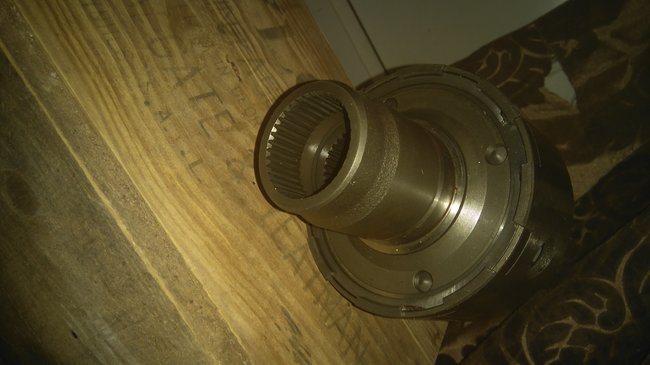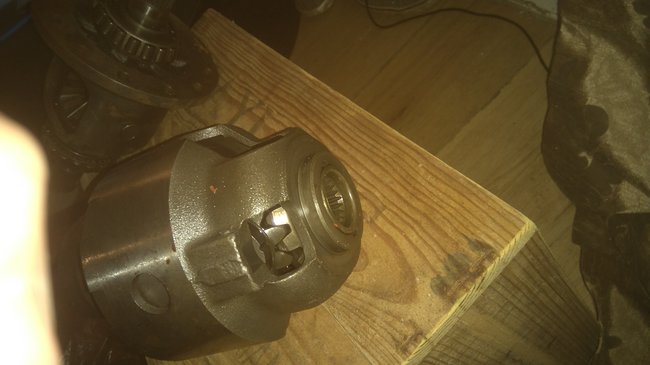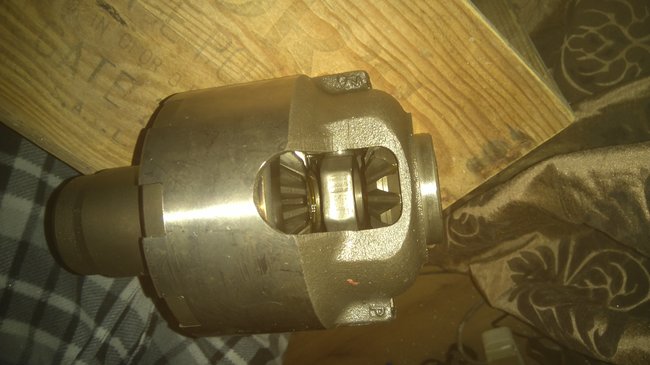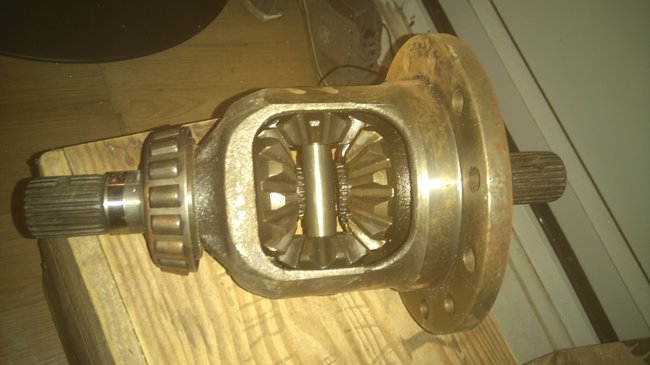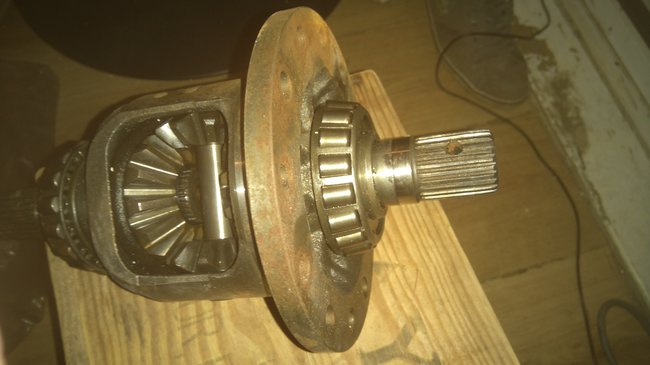Tuesday, June 6th, 2017 AT 4:56 PM
Can anyone tell me information about these parts
3 Replies
That is a differential. That is the center section for an axle. If you rotate one of the shafts, you will see the other shaft rotates the other way. The entire assembly sits on the pair of bearings, then is rotated by a spiral gear, (pinion gear), that drives a ring gear that is bolted to the large flange on the side.
You can see the two shafts turning in opposite directions, but in the vehicle, they turn at the same rate and in the same direction when the two wheels turn at the same rate. They can turn at different rates when one wheel travels further as the car goes around a corner.
You can see the two shafts turning in opposite directions, but in the vehicle, they turn at the same rate and in the same direction when the two wheels turn at the same rate. They can turn at different rates when one wheel travels further as the car goes around a corner.
SPONSORED LINKS
Was this helpful?
Yes
No
+1
Tuesday, June 6th, 2017 AT 9:17 PM
This is a differential. It is part of an axle assembly and needs to be mounted in a housing on those bearings. I do not know which car brand or model it is from. The shafts sticking out are referred to as "stub shafts". On a typical older rear-wheel-drive car, or on a pickup truck, those shafts would be about three feet long and would be inside the housing which goes from wheel to wheel on the rear. Half shafts are used on front-wheel-drive vehicles, and most of them use stub shafts on the inner CV joints that slide into the differential. Yours uses CV joints that slide onto these stub shafts. Just a different way of doing the same thing.
Your differential could be from a rear axle on a vehicle that has independent rear suspension. That system is used for ride quality and comfort, but they are extremely weak. Solid rear axles, (with those three-foot-long axle shafts), are used for strength. A solid axle is rarely damaged in a crash, even a really bad one. Parts on an independent rear suspension system can be bent from sliding into a curb or hitting a big pot hole.
The four gears inside only rotate when one wheel is rotating faster than the other one. That means they see very little wear. The ring gear bolts to the large plate on the right side of your fifth photo. The mating pinion gear mounts in the housing on a pair of bearings. Setting those up requires extreme precision, and usually special tools, gauges, and shims. Only a very small percentage of mechanics are trained for this job or specialize in it. The bearings on this assembly sit in caps that will have threaded adjusters or some other means of adjusting the entire differential left or right, and the pinion gear typically uses shims to adjust how "deep" it sits in the housing. Those adjustments are measured to the thousandths of an inch, and are critical to prevent gear noise and to reduce wear that leads to future gear noise. The specialists use a yellow ink on the gear teeth to check how they're meshing together. Where the paint rubs off shows them the contact pattern, and by that, they know which way the gears need to be adjusted.
These parts can not just be bolted together and thrown on the car. There is little chance the adjustments will be close enough to prevent noise, and in severe cases, the gear teeth could even bind from rubbing against each other so hard in areas that are not shaped to slide together smoothly as they rotate. That could cause a chattering or a crunching noise, and those noises would typically change between accelerating and coasting.
Your differential could be from a rear axle on a vehicle that has independent rear suspension. That system is used for ride quality and comfort, but they are extremely weak. Solid rear axles, (with those three-foot-long axle shafts), are used for strength. A solid axle is rarely damaged in a crash, even a really bad one. Parts on an independent rear suspension system can be bent from sliding into a curb or hitting a big pot hole.
The four gears inside only rotate when one wheel is rotating faster than the other one. That means they see very little wear. The ring gear bolts to the large plate on the right side of your fifth photo. The mating pinion gear mounts in the housing on a pair of bearings. Setting those up requires extreme precision, and usually special tools, gauges, and shims. Only a very small percentage of mechanics are trained for this job or specialize in it. The bearings on this assembly sit in caps that will have threaded adjusters or some other means of adjusting the entire differential left or right, and the pinion gear typically uses shims to adjust how "deep" it sits in the housing. Those adjustments are measured to the thousandths of an inch, and are critical to prevent gear noise and to reduce wear that leads to future gear noise. The specialists use a yellow ink on the gear teeth to check how they're meshing together. Where the paint rubs off shows them the contact pattern, and by that, they know which way the gears need to be adjusted.
These parts can not just be bolted together and thrown on the car. There is little chance the adjustments will be close enough to prevent noise, and in severe cases, the gear teeth could even bind from rubbing against each other so hard in areas that are not shaped to slide together smoothly as they rotate. That could cause a chattering or a crunching noise, and those noises would typically change between accelerating and coasting.
Was this helpful?
Yes
No
+1
Wednesday, June 7th, 2017 AT 12:58 AM
